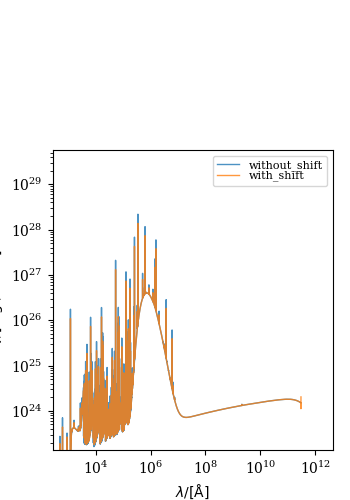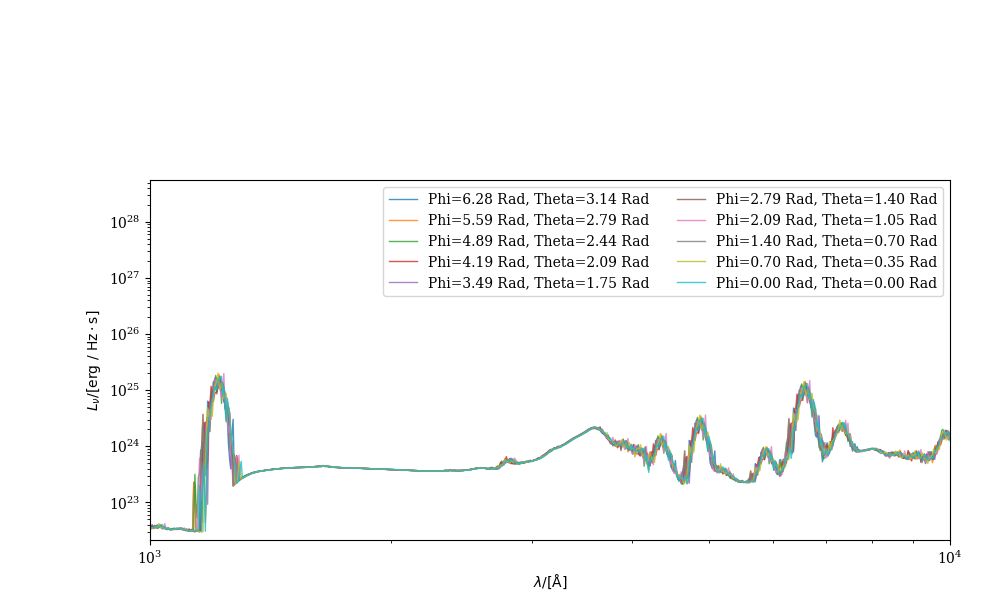Note
Go to the end to download the full example code.
Plot velocity broadened spectra¶
This example will demonstrate how to compute spectra with and without self consistent velocity broadening derived from the particle velocities.
Time to get spectra with velocity shift: 0.844642162322998
Time to get spectra without velocity shift: 0.08255267143249512
import time
import matplotlib.pyplot as plt
import numpy as np
from unyt import km, rad, s
from synthesizer import TEST_DATA_DIR
from synthesizer.emission_models import NebularEmission
from synthesizer.emissions import plot_spectra
from synthesizer.grid import Grid
from synthesizer.load_data.load_camels import load_CAMELS_IllustrisTNG
plt.rcParams["font.family"] = "DeJavu Serif"
plt.rcParams["font.serif"] = ["Times New Roman"]
# Set the seed
np.random.seed(42)
# Define the grid
grid_name = "test_grid"
grid = Grid(grid_name)
# Define the model with velocity shift
model = NebularEmission(grid, vel_shift=True)
# Create galaxy object
galaxy = load_CAMELS_IllustrisTNG(
TEST_DATA_DIR,
snap_name="camels_snap.hdf5",
group_name="camels_subhalo.hdf5",
physical=True,
)[0]
# Invent some fake velocities for the stars (with a bulk moving towards us)
galaxy.stars.velocities = (
np.random.normal(100, 500, galaxy.stars.coordinates.shape) * km / s
)
# Get the spectra
start_with_shift = time.time()
galaxy.stars.get_spectra(model)
print(
"Time to get spectra with velocity shift:"
f" {time.time() - start_with_shift}"
)
# Unpack the spectra with the velocity broadening
with_shift = galaxy.stars.spectra["nebular"]
# Clear the spectra
galaxy.clear_all_emissions()
# Get the spectra without the velocity broadening (we could use the
# set_vel_shift method on an EmissionModel to turn off the velocity shift
# but here we demonstrate how to do it with the get_spectra method's
# overides)
start_without_shift = time.time()
galaxy.stars.get_spectra(model, vel_shift=False)
print(
"Time to get spectra without velocity shift:"
f" {time.time() - start_without_shift}"
)
# Unpack the spectra without the velocity broadening
without_shift = galaxy.stars.spectra["nebular"]
# Plot the two spectra
plot_spectra(
spectra={"with_shift": with_shift, "without_shift": without_shift},
show=True,
)
# Exagerate the velocities for the next part
galaxy.stars.velocities *= 10
# Compute the velocity broadened spectra for a range of random rotations
# and plot the difference in the spectra
phis = np.linspace(0, 2 * np.pi, 10) * rad
thetas = np.linspace(0, np.pi, 10) * rad
spectra = {}
for phi, theta in zip(phis, thetas):
# Rotate the stars
galaxy.stars.rotate_particles(phi, theta)
# Get the spectra
spec = galaxy.stars.get_spectra(model, vel_shift=True)
# Store it for plotting
spectra[f"phi={phi:.2f}, theta={theta:.2f}"] = spec
# Plot the spectra
fig, ax = plot_spectra(
spectra, xlimits=(10**3, 10**4), show=False, figsize=(10, 6)
)
# Modify the legend
ax.legend(ncol=2)
plt.show()
Total running time of the script: (0 minutes 9.907 seconds)

